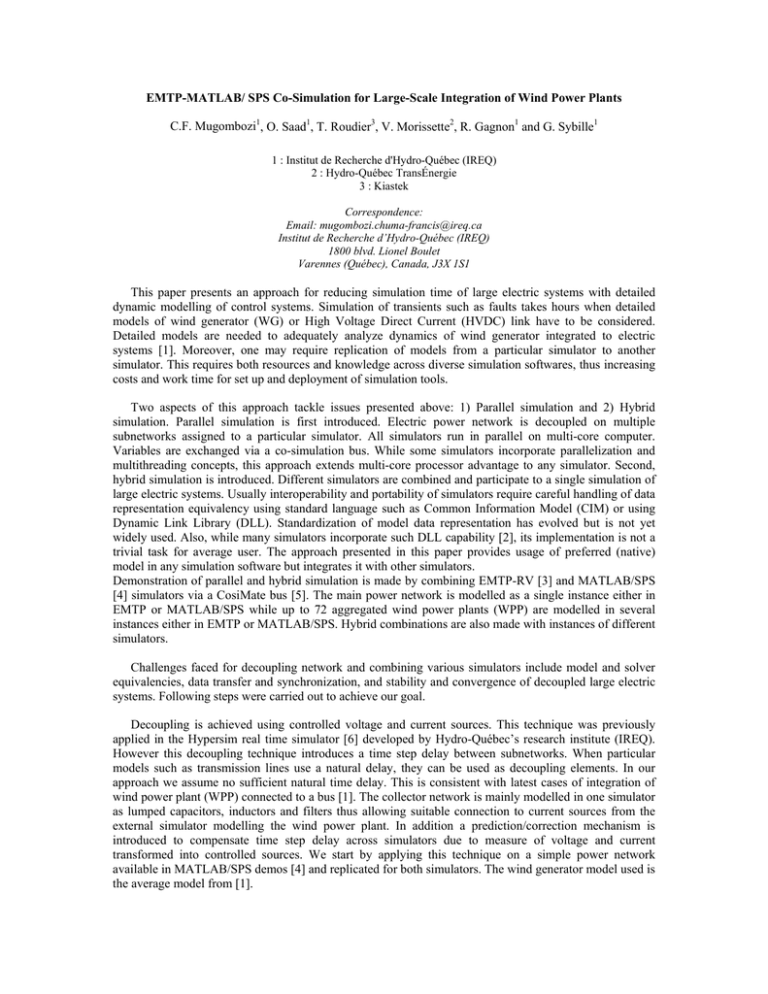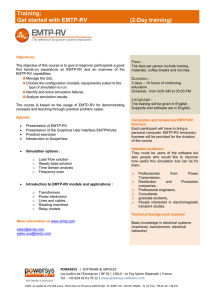EMTP-MATLAB Co-Simulation for Wind Power Plant Integration
advertisement

EMTP-MATLAB/ SPS Co-Simulation for Large-Scale Integration of Wind Power Plants C.F. Mugombozi1, O. Saad1, T. Roudier3, V. Morissette2, R. Gagnon1 and G. Sybille1 1 : Institut de Recherche d'Hydro-Québec (IREQ) 2 : Hydro-Québec TransÉnergie 3 : Kiastek Correspondence: Email: mugombozi.chuma-francis@ireq.ca Institut de Recherche d’Hydro-Québec (IREQ) 1800 blvd. Lionel Boulet Varennes (Québec), Canada, J3X 1S1 This paper presents an approach for reducing simulation time of large electric systems with detailed dynamic modelling of control systems. Simulation of transients such as faults takes hours when detailed models of wind generator (WG) or High Voltage Direct Current (HVDC) link have to be considered. Detailed models are needed to adequately analyze dynamics of wind generator integrated to electric systems [1]. Moreover, one may require replication of models from a particular simulator to another simulator. This requires both resources and knowledge across diverse simulation softwares, thus increasing costs and work time for set up and deployment of simulation tools. Two aspects of this approach tackle issues presented above: 1) Parallel simulation and 2) Hybrid simulation. Parallel simulation is first introduced. Electric power network is decoupled on multiple subnetworks assigned to a particular simulator. All simulators run in parallel on multi-core computer. Variables are exchanged via a co-simulation bus. While some simulators incorporate parallelization and multithreading concepts, this approach extends multi-core processor advantage to any simulator. Second, hybrid simulation is introduced. Different simulators are combined and participate to a single simulation of large electric systems. Usually interoperability and portability of simulators require careful handling of data representation equivalency using standard language such as Common Information Model (CIM) or using Dynamic Link Library (DLL). Standardization of model data representation has evolved but is not yet widely used. Also, while many simulators incorporate such DLL capability [2], its implementation is not a trivial task for average user. The approach presented in this paper provides usage of preferred (native) model in any simulation software but integrates it with other simulators. Demonstration of parallel and hybrid simulation is made by combining EMTP-RV [3] and MATLAB/SPS [4] simulators via a CosiMate bus [5]. The main power network is modelled as a single instance either in EMTP or MATLAB/SPS while up to 72 aggregated wind power plants (WPP) are modelled in several instances either in EMTP or MATLAB/SPS. Hybrid combinations are also made with instances of different simulators. Challenges faced for decoupling network and combining various simulators include model and solver equivalencies, data transfer and synchronization, and stability and convergence of decoupled large electric systems. Following steps were carried out to achieve our goal. Decoupling is achieved using controlled voltage and current sources. This technique was previously applied in the Hypersim real time simulator [6] developed by Hydro-Québec’s research institute (IREQ). However this decoupling technique introduces a time step delay between subnetworks. When particular models such as transmission lines use a natural delay, they can be used as decoupling elements. In our approach we assume no sufficient natural time delay. This is consistent with latest cases of integration of wind power plant (WPP) connected to a bus [1]. The collector network is mainly modelled in one simulator as lumped capacitors, inductors and filters thus allowing suitable connection to current sources from the external simulator modelling the wind power plant. In addition a prediction/correction mechanism is introduced to compensate time step delay across simulators due to measure of voltage and current transformed into controlled sources. We start by applying this technique on a simple power network available in MATLAB/SPS demos [4] and replicated for both simulators. The wind generator model used is the average model from [1]. Models and solver equivalencies of EMTP and MATLAB/SPS simulators are achieved by setting similar method of solution, namely trapezoidal integration method, and by modifying a number of control parameters (proportional and integral gains) or changing control strategies, for instance, for reactive energy in WPP model, to minimize as best as possible initialization discrepancies between EMTP and MATLAB/SPS solvers. Other sources of discrepancies between simulators include modelling of Phaselocked loop (PLL) elements, measuring blocks and simultaneity of solution of control and power network equations. Impacts of possible differences of simulators on synchronicity of data exchanged trough the interface have to be considered. Synchronization is assessed by comparing instantaneous power injected by the wind generator from MATLAB/SPS to EMTP, and vice versa. Time step is set to 50 or 25 microseconds for all cases. All single-simulator and hybrid cases match very well for all signals including instantaneous power and DC voltage inside wind generator model. Several tests were performed on a 21-bus simplified model of Hydro-Québec (HQ) system (Fig. 1) and on modified IEEE 39-bus systems with detailed model of generators. In order to analyze impact of different computation loads on CPU, 6, 12, 32 and 72 WPPs were respectively connected to HQ 21-bus and IEEE 39-bus while maintaining initial generated power on buses. Each WPP is divided in two within the same EMTP instance or MATLAB instance. For dynamic analysis a ten cycles fault is applied near bus 33 at 10 seconds for 20 seconds time frame and near MTL bus at 0.2 seconds for 4 seconds time frame for respectively modified IEEE 39-bus and HQ 21-bus systems. The reference simulation times are cases without decoupling. As expected, best performances are obtained when computation load is equally shared between processors. Also, gain in simulation time diminishes when any core is over-loaded thus becoming a bottle neck for data exchange in whole system. All Gains obtained by proposed approach are presented in Fig.2. A maximum gain of 7 is obtained for case 14 running on 8 core CPU computer. Still some improvement for generic decoupling method is needed. Nonetheless gain obtained may reduce work time required for simulation and by ricochet contribute to reduction of overall cost involved. References [1] R. Gagnon, G. Turmel, C. Larose, J. Brochu, G. Sybille, M. Fecteau, Large-Scale Real-Time Simulation of Wind Power Plants into Hydro-Québec Power System, 9th International Workshop on Large-Scale Integration of Wind Power into Power Systems as well as on Transmission Networks for Offshore Wind Power Plants, 18-19 October 2010, Quebec city, Quebec, Canada [2] O. Saad, Computation of power system transients: modeling portability using EMTP-RV DLL, Panel session on interoperability and portability, IEEE Power and Energy Society General meeting, 2011, Detroit [3] DCG-EMTP, EMTP-RV 2.2, Electromagnetics Transients Program: http://www.emtp.com. [4] MATLAB/Simulink, The MathWorks Inc, Software Package for Modeling and Analyzing Dynamic Systems: http://www.mathworks.com [5] CosiMate, Kiastek: http://www.cosimate.com [6] V-Q. Do, J-C. Soumagne, G. Sybille, G. Turmel, P. Giroux, G. Cloutier, S. Poulin, Hypersim, an integrated real-time simulator for power networks and control systems, Third International Conference on Digital Power System Simulators - ICDS 99, Vasteras, Sweden, 1999 QUE7a QUE7b QUE7c cC MIC7c MIC7b C Cs SAG bB Cs SAG7 B LNOE aA bB cC aA PSS_select Reseau Nord-Est A CHM7c CHM7b CHM7a SIMPLIFIED HQ 21-BUS Reseau Nord-Ouest A B C 1 MTLc STATUT STABILISATEURS: PSS=0 hors service; PSS=1 Puissance (dPa); PSS=2 Multibande (dw) MTLb MTLa powergui MIC7a Discrete, Ts = 5e-005 s. LNEO SAG PSS Cs CHM-JCA Cs CHMS QUE7 aA bB cC c b a C B c b Xfo3 C a B A C B Xfo2 A MTL-QUE A c b a MTL7 Xfo1 INTERFACE WPP Three-Phase Fault A Eoliennes Mtl m m A B B Vf _ C Eoliennes Qc C C A Vf B A A B C Q-MTL A F-QUE C B A INTERFACE WPP A B C A B C B_5 MTL Regulateurs5 C Pm B Pm B F-MTL C-MTL 5%Pnom C Eoliennes Mtl1 Eoliennes Qc1 A B C ====================================================================== c A c C c C A5 A B25 575V - 25 kV/ 575 V 1.75MVA 3 exin_disc v2.0 b s c em FROM OTHER SIMULATOR B5 + C Iabc_25_Qc Vabc_25_Qc - B DATA TRANFER PORT: CURRENT INPUTS aB s b + a B DATA TRANFER PORT: VOLTAGE OUTPUTS C A 2 exout_disc v2.0 1/z A B INTERFACE WPP & POWER NETWORK 1 Filter1 Q=50 ====================================================================== [Vdc3] <Vdc_V> [wr3] <wr_pu (IG speed)> 12 Wind (m/s) m 0 [Vabc_25_QC] [Q_pu3] <Q_pu> Qref _pu Vabc (V) [P_pu3] <P_pu> [Iabc_25Qcl] Iabc (A) DFIG Wind Turbine6 MATLAB SIMULINK BLOCK OF WPP EMTP-RV BLOCKS OF WPP AND PREDICTION CORRECTION Figure 1 Simplified system of HQ 21-bus interfaced via CosiMate ports with MATLAB/SPS and EMTP Model of WPP 8 Core CPU 20 16 11 7 5 3 21 9 17 2 1 case no case no 4 Core CPU 0 1 2 3 4 Gain = T standard / T CosiMate 14 22 15 18 13 23 8 10 4 6 19 0 2 4 6 Gain = T standard / T CosiMate 8 Figure 2 Gains in simulation times (T standard = not decoupled)



